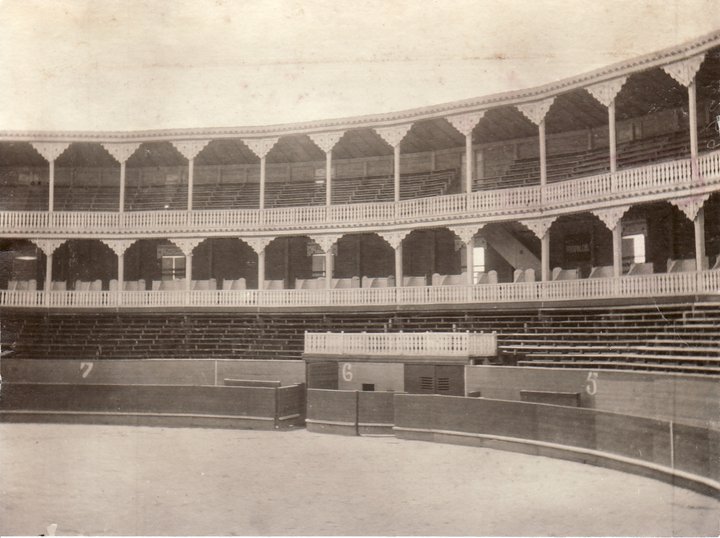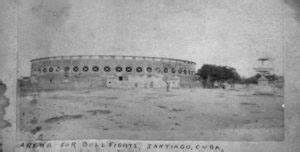PERSONAJES DE NUESTRA VIEJA HABANA: GLORIA “LA PROSTITUTA TORERA”. CORRIDAS DE TOROS EN CUBA. PHOTOS.
LA COLONIZACIÓN DE CUBA por los españoles, aparte del idioma, la influencia en la música, la gastronomía, costumbres y todos los aspectos de la vida no podía dejar de imponernos también un entretenimiento cruel y sanguinario que por suerte ha sido suprimido posteriormente. Me refiero a las corridas de toros.
En 1796 era conocida en Cuba una plaza de toros en el sitio en que hoy se cruzan las calles Monte y Egido y en el siguiente siglo existieron muchas otras en todo el país, siendo las más reconocidas las situadas en La Habana. Entre ellas estuvo la Plaza de Toros de Belascoaín, conocida también como de La Habana, por su importancia, y que se mantuvo activa hasta que en 1897 un terrible incendio la destruyó.
También fueron famosas la Plaza de Toros de la Calle Águila, en 1818; la del Campo de Marte, en 1825; las de Regla, en 1842 y una segunda en 1866, en donde le gustaba torear al famoso Manzantini y finalmente la Plaza de Toros de Carlos III e Infanta, la que, junto a la segunda de Regla, se mantuvo activa hasta 1899, con el fin de la dominación española.
Esta fue la mejor plaza de toros que existió en La Habana Infanta, que se llamó así por esa calzada, aunque realmente su frente daba a Carlos III y donde después estuvo el cine Manzanares y ahora quién sabe las ruinas que allí existan.
Por esta plaza pasaron los mejores toreros de la época y se dieron las mejores corridas de la Isla. Era una gradería circular con un bonito techo, contaba con capacidad de hasta diez mil personas y tenía 55 palcos sombreados entre ellos el del Capitán General de la Isla.
Por supuesto que Luis Mazzantini tampoco se podía perder su actuación en esta plaza, para lo que se dice se batieron récords de precio con diez pesos la entrada y cinco para las graderías de sol, una suma exorbitante entonces. En varios artículos hemos hecho referencia a la expresión popular cubana: “ni Mazantín el torero”, que se refiere a algo muy difícil de realizar, en comparación con la maestría del torero en algo tan repulsivo como matar a un animal indefenso después de torturarlo.
En esta plaza sufrió su única corneada en toda su carrera Antonio Guerra, “Guerrita” que moriría rico en España tras haber asesinado toros en medio mundo así como muchos otros toreros de fama mundial como Currito Cuchares, Hermosilla, El Sacaso, El Minuto y Paco Merluza. El de nombre de pescado era tan malo como torero que cada vez que salía a la arena el público lo insultaba.
GLORIA “LA CANGREJERA….”
Pero lo más impactante de esta plaza, fue que en ella hizo su aparición Gloria la Torera.
Que se cuenta pasó en la cronica chismosa de entonces como “Gloria la Cangrejera… tan puta como torera”.
Con una propaganda impresionante se decía que Gloria era la mejor matadora andaluza de todos los tiempos, por lo que a lleno completo a finales de 1890, los habaneros estaban ansiosos de ver a esa personalidad y la Plaza recaudó más dinero que cuando Mazzantini (60 mil pesos contra 80 mil la torera).
La expectación era tremenda pero cuando “la andaluza” salió a la arena todos vieron con asombro que en vez de un furioso Miura salió a enfrentarla un tímido becerrito.
Ahí no quedó el escándalo, todos se sentían estafados y algunos reconocieron en Gloria la Torera a Gloria la Cangrejera, una prostituta vecina de la calle de la Bomba, a quien los promotores habían convencido de participar en la jugada por una paga miserable.
Aquello se acabó como la fiesta del Guatao ((una de las trifulcas más famosas en la historia de Cuba ocurrida en el pueblito del Guatao en la provincia de La Habana, donde se produjo una descomunal riña entre los asistentes a una fiesta). La indignación devino en cólera, la gente exigía la devolución de lo pagado y al final degeneró en una de las riñas tumultuarias más grandes que recuerda La Habana, con decenas de heridos y el arresto de otros tantos, entre ellos la falsa torera.
No se si a Gloria le dirían la cangrejera porque ello es sinónimo de mujeres que pueden contraer violentamente la vagina.
El final no es muy conocido, pero lo que sí fue un hecho es que la cultura del toreo en Cuba desapareció por varias razones, entre ellas se dice que porque era demasiado española en momentos en que hacían rechazo hacia la dominación colonial (por qué no rechazaron la fabada, el caldo gallego o el chocolate con churros que también eran demasiado españoles), pero yo creo que las razones estuvieron dadas porque en las plazas de toros era muy evidente el privilegio de que hacían gala la clase dominante política y militar, españolizante y cerrada al intercambio con los cubanos y además porque apareció la verdadera pasión del cubano: el béisbol, que contó con rápida asimilación.
Seguramente que la pobre meretriz pagó los platos rotos y los delincuentes estafadores se fueron con la plata. Pero así es el ser humano. Si yo pudiera soltaría desnudos a los toreros en el ruedo y que se las tuvieran que ver con varios toros a la vez a ver si les hacía gracia.
CHARACTERS OF OUR OLD HAVANA: GLORIA “THE PROSTITUTE BULLFIGHTER”. BULLFIGHTS IN CUBA. PHOTOS.
THE COLONIZATION OF CUBA by the Spaniards, apart from the language, the influence on music, gastronomy, customs, and all aspects of life could not help but also impose a cruel and bloody entertainment on us that luckily has been suppressed later. I mean bullfighting.
In 1796, a bullring was known in Cuba in the place where Monte and Egido streets intersect today, and in the following century there were many others throughout the country, the most recognized being those located in Havana. Among them was the Belascoaín Bullring, also known as Havana, due to its importance, and which remained active until a terrible fire destroyed it in 1897.
Also famous were the Plaza de Toros de la Calle Águila, in 1818; that of the Field of Mars, in 1825; those of Regla, in 1842 and the second one in 1866, where the famous Manzantini liked to fight and finally the Plaza de Toros de Carlos III e Infanta, which, together with the second one of Regla, remained active until 1899, with the end of Spanish domination.
This was the best bullring that existed in Havana Infanta, which was named after that road, although its front really faced Carlos III and where the Manzanares cinema was later and now who knows what ruins there are.
The best bullfighters of the time passed through this plaza and the best bullfights on the Island took place. It was a circular grandstand with a beautiful roof, it had a capacity of up to ten thousand people and had 55 shaded boxes, including that of the Captain General of the Island.
Of course, Luis Mazzantini could not miss his performance in this square either, for what is said price records were broken with ten pesos for the ticket and five for the sun stands, an exorbitant sum at the time. In several articles, we have made reference to the Cuban popular expression: “not even Mazantín el torero”, which refers to something very difficult to do, compared to the mastery of the bullfighter in something as repulsive as killing a defenseless animal after torturing it.
Antonio Guerra, “Guerrita” who would die rich in Spain after having killed bulls in half the world as well as many other world-famous bullfighters such as Currito Cuchares, Hermosilla, El Sacaso, El Minuto, and Paco, suffered his only goring in his entire career in this bullring. Hake. The one with the name of the fish was so bad as a bullfighter that every time he went out into the arena the public insulted him.
GLORIA “THE CANGREJERA….”
But the most impressive thing about this square was that Gloria la Torera appeared in it.
What is said happened in the gossipy chronicle of that time as “Gloria la Cangrejera… as much a whore as a bullfighter”.
With impressive propaganda, it was said that Gloria was the best Andalusian matador of all time, so that at the end of 1890, the people of Havana were full of people eager to see that personality and the Plaza raised more money than when Mazzantini (60 thousand pesos against 80 thousand the bullfighter).
The expectation was tremendous, but when “the Andalusian” came out to the arena, everyone saw with astonishment that instead of a furious Miura, a timid little calf came out to confront her.
The scandal did not stop there, everyone felt cheated and some recognized in Gloria la Torera Gloria la Cangrejera, a prostitute from Calle de la Bomba, whom the promoters had convinced to participate in the play for a miserable pay.
That ended like the Guatao party ((one of the most famous brawls in the history of Cuba that occurred in the small town of Guatao in the province of Havana, where a huge brawl broke out among those attending a party). The outrage turned into anger, people demanded the return of what was paid and in the end it degenerated into one of the biggest riotous fights that Havana remembers, with dozens of wounded and the arrest of many others, among them the false bullfighter.
I don’t know if Gloria would be called the crab girl because that is synonymous with women who can violently contract their vagina.
The ending is not well known, but what was a fact is that the culture of bullfighting in Cuba disappeared for various reasons, among them it is said that it was too Spanish at a time when they rejected colonial domination (why not they rejected the fabada, the Galician broth or the chocolate with churros that were also too Spanish), but I think that the reasons were given because in the bullrings the privilege that the ruling political and military class, Spanishizing and closed to the exchange with the Cubans and also because the true passion of the Cuban appeared: baseball, which was quickly assimilated.
Surely the poor prostitute paid for the broken dishes and the criminal swindlers left with the money. But such is the human being. If I could, I would let the bullfighters naked in the ring and have them deal with several bulls at the same time to see if they liked it.
Agencies/ MemoriasCubanas/ Carlos RodriguezB./ Extractos/ Excerpts/ Internet Photos/ Arnoldo Varona/ www.TheCubanHistory.com
THE CUBAN HISTORY, HOLLYWOOD.












